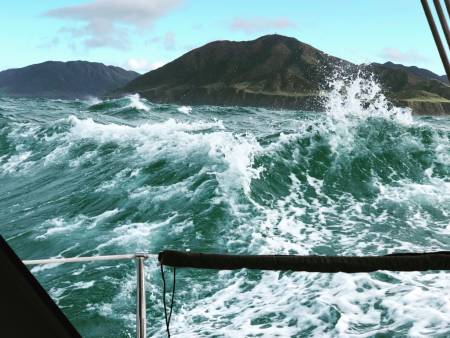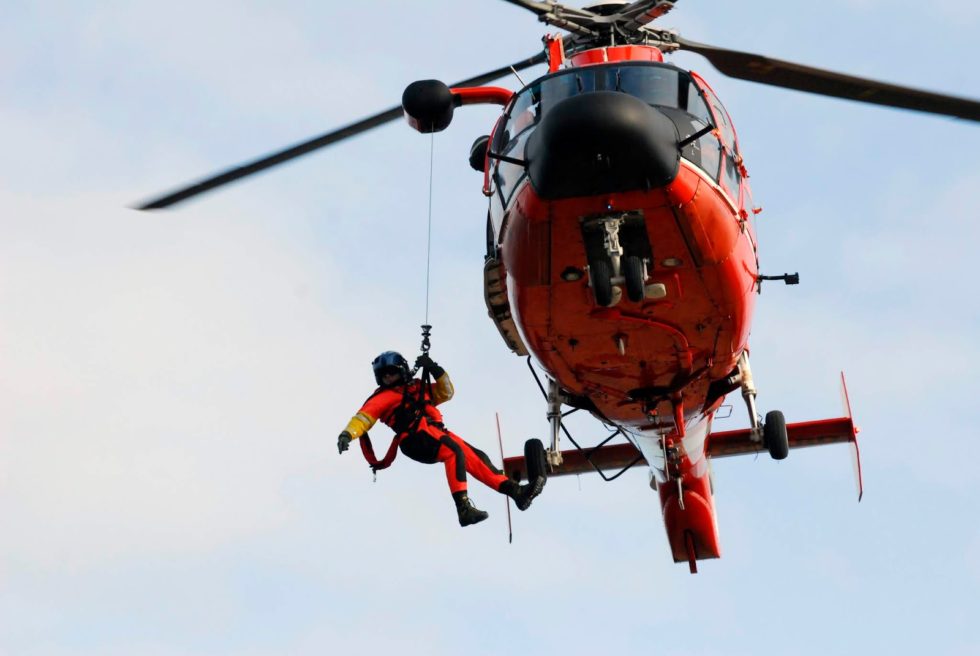Rogue Waves – A First Hand Story of Survival
The cruising life is not all plain sailing as many sailors will have experienced. Mistakes can occur and unforeseen events can happen, such as being hit by rogue waves. Despite thinking they had everything covered when setting off on a voyage from the US east coast to the Bahamas, Mark and Susan experienced just this scenario which resulted in a rescue by the United States Coast Guard and the loss of their boat.
Published 6 hours ago
The skipper, Mark* had almost 50 years of sailing experience, clocking up over 50000 NM as a hobbyist on a sailing yacht and as a professional on a motor vessel, while first mate Susan* had done over 15000NM with Mark as a two-person team. Heavy seas and strong winds were not unusual for them. A daily forecast was a must so that they could easily find a safe hiding place ahead of storms and hurricanes. In this report for Noonsite, Mark tells how it all went wrong on what should have been a six to eight day sail from the east coast of the USA to Bermuda.
*Note: Names have been changed for privacy reasons and due to insurance claims issues.
Our Home and Our Transportation
We had owned our boat for almost six years. It was a 50-foot ocean, blue-water sailboat and was our home and transportation. It had taken us from the Mediterranean Sea and across the Atlantic Ocean. For the last four years we have spent the winters in the Caribbean and the summers in the United States or Canada.
I believed the boat was in excellent condition. In an insurance survey conducted a few months before the event recounted in this story, the surveyor had no comments at all, which he said was unusual. Many parts had been replaced and renewed, including a new genoa sail, a new thermostat for the engine, a new starter battery, a new refrigerator and much more.
Since the boat was traveling long distances and we were only two people on board, the boat was equipped with a combination of two autopilots: two controllers and two drive units that we could operate by simple switching. Any of the controllers could operate any of the drive units. One of the controllers was IPX7 protected.
Waiting for a Weather Window
The (final) cruise was from Norfolk/Hampton, VA, USA, toward Bermuda. We stayed anchored at Mill Creek, near Hampton, VA, for two weeks, looking for a weather window. After a post-hurricane influence declined, it seemed as if there was a suitable weather window. It was far from perfect but acceptable. The distance between the south openings of the Chesapeake Bay Bridge-Tunnel to Bermuda was 630 NM and based on experience, the trip should have taken between four to six days. The forecast predicted a strong wind (25-30Kt) with sailing points of broad reach to running for the first two days. The wave forecast was up to four meter waves, for a duration of 12 hours. After that, the wind was forecast to turn clockwise and decrease for the next about 24 hours with waves of around two meters and near the cruise end, we should have faced close-hauled or into the wind of 15-25 Kt with waves up to 2.5 meters.
After consulting with a more experienced sailor, I concluded that it would not be a pleasant or fun sail, quite bumpy, but possible and safe. There was no point in waiting for another, calmer weather window since more weather depressions were starting to develop in the Caribbean Sea. In fact, a significant post-hurricane storm passed between Bermuda and the US two weeks after the event and at least two hurricanes occurred shortly thereafter.
Almost Fun
It was almost a fun sail on the second day morning. The broad reach apparent wind was about 20-25Kt with long waves of 3-4 meters. The speed was 7-9 knots with almost a full genoa (folded about four rounds on the roller). When waves came behind and lifted the stern and slightly turned the boat, the course deviation was not larger than 10-20 degrees. I played with the autopilot response between stages one to three to find the optimum between course deviation and electric consumption. There was very little difference.
When the boat reached the wave’s bottom, there was no water on the bow deck. We had set the dodger a day before, so we were protected all around from the wind. The Cunningham rope from the genoa got disconnected in a way that might tangle it with the jib roller drum and electric engine. Although there was no water on the deck, I didn’t like to risk some spray and decided to fix it later, when the forecast predicted some smaller waves. Unfortunately, that never happened.
Waves and Water
Susan had taken a lookout shift and I was lying down on the bed that was closest to the cockpit, resting after the night shift. At about 2.00 PM, a big wave hit the boat and spilled water into the cockpit towards the cabin. Susan was trying to close the door into the cabin and I rushed to the cockpit but then maybe a few seconds later, another huge wave covered the boat.
We tilted – maybe 50-70 degrees. The wave ruptured the dodger back fabric, broke one of the dodger’s supports and flooded the cockpit. Susan was up to her chest in water. A lot of water spilled into the cabin. We were lucky that this event happened when Susan was in the center cockpit (a larger distance from the point of impact) and she was partly protected by the dodger (that took some of the energy from the wave). If she were in an aft cockpit without an all-around dodger, she would have probably been swept away to the ocean.


All kinds of stuff, like a stove, sheets, pans, fruit, containers, and more, were on the wet cabin floor after they hit the opposite starboard wall. Susan went down to start arranging the mess while I started to figure out what just happened and do damage control. A few seconds later, the autopilot showed an error message and stopped working. I switched to the secondary autopilot controller that was working but a few seconds later, all the electronics, including the secondary autopilot, shut down, except the VHF radio and we were forced to helm the boat manually.
Switching places, Susan was steering and I started to bail water from the cabin (there is no bilge pump for the main cabin) together with some damage control. After 20 or 30 buckets of about 20 liters and the end of the search, without success, to restore the electricity, which took about 15 to 45 minutes, Susan started to feel back pain. I took the steering wheel. It was very stiff; a lot of force was needed to rotate it. That is probably why Susan could not steer more than a few minutes at a time We could not steer well and a course error of 30-40 degrees was very frequent. Sometimes we were even broadside to the waves.
We were confused and afraid, especially that more huge waves would break on the boat. We should have worn life vests with harnesses and tied ourselves to the boat, but we didn’t, we just tried to steer the yacht with a lot of physical effort.
Run with the Waves
The best thing to do in such a situation is to run with the waves. When you run before, with the stern facing the waves, there is less interaction with the waves and consequently fewer helm movements. You can also use a reefed front sail to help with maintaining the course.
The distance to Bermuda was approximately 400NM, with, at this time, the wind and waves. The distance to the USA east coast was approximately 200NM in opposition to the wind and waves. In any case, considering our ability to steer the boat manually, it would take maybe 6-8 days before we saw land again.
You have to be very strong and decisive to manually steer a stiff rudder in such a sea state, for three to four hours. Then you need a break, for two or three hours, to regain the ability to steer manually again. And that is if you can sleep and not spend physical effort trying to keep yourself from falling from the mattress. After another 15 to 30 minutes, we concluded that we could steer manually only for a very few hours. Dropping an anchor in that place was impossible because of the depth. Setting a sea anchor by one person, with long ropes and chains, in that sea state and with limited maneuverability, was basically suicide.
So, it was very likely that we could not safely reach land and correspondingly would be lost at sea. So we made the decision to call for rescue. But before the United States Coast Guard (USCG) arrived and lifted us off our boat, we noticed, checked and did the following.
Our Situation – what we did and didn’t do
An old Inmarsat C (satellite communication) hanging above the chart table, two meters from the door, started making a sound of truncated beeping. The generator was cranking but didn’t start. The engine was OK and started immediately right after the electricity fault. The idea was to have some prop wash on the rudder plate, to improve maneuverability.
However, the battery monitor indicated a charge of 20A when the engine was operating, but the reading of voltage was 0.4 volts on the battery bank. After we started the engine we didn’t shut it down because there was no guarantee that it would start again. We should have looked at the engine compartment, but didn’t.
A frame of a solar panel on the stern broke from one of its supporters and was hanging diagonally, very close to the water and some electric cables were strewn all over the stern deck. A mirror at the back head fell and broke. The mirror fragments were all over the aft cabin.
Our navigation devices (smartphone and Inreach) were both operated by battery and needed charging with a 220V charger (or a car charger but we couldn’t remember if we had one on the boat). We could probably navigate for about two days or a little more if we operated a power-saving plan. However, this meant that if we decided to sail to Bermuda, we could miss the Island.
We reefed the genoa almost completely and used both the sheets that the clew was in the middle of the boat. We were not sure that the remaining sail area was enough to make the bow go downwind. She kept turning to a beam reach and stayed there because of the steering problem.
When I tried to restore the electricity, I examined the electrical panels to see if any fuses were jumped or burnt. Unfortunately, everything seemed fine there. However, when I checked the compartment on the other side of the helm, where most of the electronic boxes are kept, it was all wet. The walls and electronic boxes had water droplets on them and there was about half an inch of water at the bottom. So, even if we had closed the cockpit door, the electrical damage would have still happened when the waves came in.
United States Coast Guard to the Rescue
We had two EPIRBs (one was old for which we could not find a battery replacement, so we bought a new one), two Personal Locator Beacons attached to life vests and a Garmin inReach Explorer+. All were registered. We operated the new EPIRB and sent an SOS on the inReach. Susan operated the DSC on the VHF and transmitted a MAYDAY call. Nobody answered.
GEOS (the Emergency care service associated with inReach) responded in no time with a text message. They asked for some details. I was on the helm and managed to write a text message: “cant”. because two hands were needed to operate the stiff helm and full focus was needed to keep the course.
We then received another text message that the USCG was sending a helicopter and the ETA was one hour. A while later, we received a VHF call from the USCG. I can’t remember the precise details but there was a lot of “USCG, I don’t understand you, please repeat, over” from them. We asked what the rescue methods were and if we could take a waterproof bag (with passport, money, underwear) but were told to ask the helicopter.
USCG asked us to put on our life vests and asked if we had survival wetsuits. Unfortunately we had only dive wetsuits. We understood we needed protection from hypothermia and that we would need to put on some clothes and shoes before we put on the life vests.
Susan mistakenly operated the CO2 container and the life vest choked her and interrupted her movement. We managed to remove some of the gas with the filling tube.We then heard the USCG helicopter trying to contact us on VHF and after a few minutes we saw it.
The Coast Guard told us to completely close the genoa. The helicopter did a few rounds above us and then positioned itself downwind at 150-160 degrees on the starboard side. The swimmer came down with a cable, released himself from the cable and we were asked to have one person jump into the water and head towards the swimmer. Susan jumped into the water. It was a little complicated since the solar panel blocked the path to the stern. She jumped on the port side that was windward, while the swimmer was on the leeward. The boat moved a little forward and the swimmer and Susan met.


The helicopter was nearby all the time and lit up the area. They lowered a basket, the swimmer put Susan into the basket which was then lifted up to the helicopter. A cable was then lowered again and the swimmer was lifted to the helicopter. After a few minutes, the helicopter approached again to collect me.
Although the water wasn’t cold, probably because of the Gulf stream, we were shaking. We were offered blankets and headphones for protection from the noise and for talking to the helicopter crew. Susan still had back pain and the pilot said that an ambulance would wait for them. Susan said it wasn’t necessary. The pilot told us that if our position was a little more to the east, an airborne rescue was impossible and we would probably have had to wait until a USCG ship rescued us and it would take at least another day or two or… the helicopter crew probably asked us more questions, but it was hard to understand, mainly because of the noise.
Two hours later, we arrived at the USCG air station in Elizabeth City, North Carolina. The ambulance crew attended to Susan’s back pain, but she required no treatment as the pain had nearly vanished. Members of the USCG then guided us to a comforting shower, provided dry clothing and flip-flops and even treated us to some pizza. Following expressions of gratitude for their life-saving efforts and a series of photos, Coast Guard personnel arranged accommodation for us at at a nearby hotel and drove us there.
Funny and sad anecdote: it was not until we were at the USCG airbase and all the rescue crew were taking success photos with us (success for USCG crew), that we realised there were actually two aircraft involved in the rescue mission..
My Summary and learnings
- At all times, one must take care of the safety and well-being of the crew, especially in emergencies. Therefore,you should always first put on life vests and secure yourselves to the boat with harnesses.
- If you install a water-resistant system, such as one with an IPX7 rating, ensure that the system is protected from end to end, from the battery to the final electrical component.
- If you are planning an extended sailing journey, ensure that all essential boat operations can be performed manually. With more than two or three crew members, it may not be necessary to seek external assistance in the event of such an incident.
- Emergency events often come as surprises. You can’t guarantee that your thoughts and actions will be as clear as when you’re calmly sitting on your couch contemplating emergency scenarios.
- Mistakes can occur in any situation. In certain emergency situations, external assistance may be necessary and could make the difference between life and death. Therefore, ensure in advance that you have communication devices available to call for help.
…………………………………
Mark and Susan wanted to share their story so that fellow sailors could learn from it. It was also their way to repay, at the very least, the United States Coast Guard for the rescue.
“If some mariner adjusts their planning and prevents an emergency, it could mean that a USCG rescuer doesn’t have to undertake a life-threatening mission,” said Mark.
…………………………………
The opinions expressed in this article are the author’s own and do not reflect the view of Noonsite.com or World Cruising Club.
…………………………………
Find out all news, reports, links and comments posted on Noonsite, plus cruising information from around the world, by subscribing to our FREE monthly newsletter. Go to https://www.noonsite.com/newsletter/.
Related to the following Cruising Resources: General, Incident Reports, Safety, Safety and Medical



